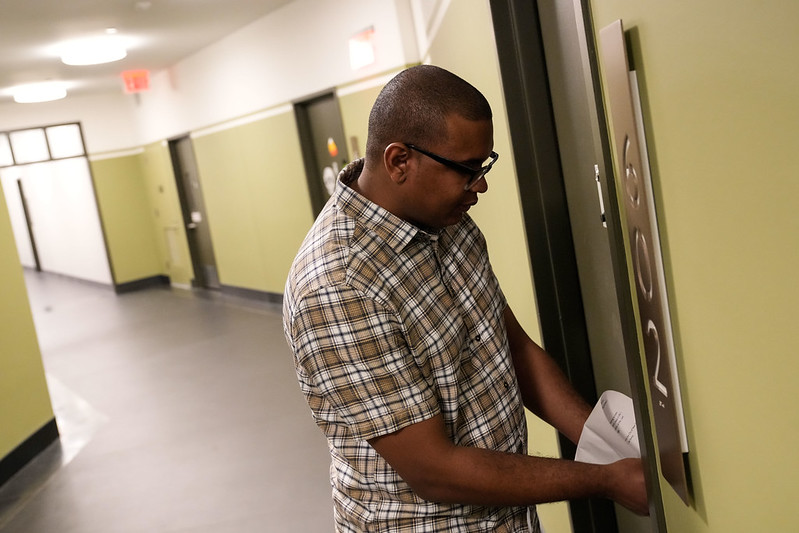
Heading home (photo: Michael Appleton/Mayoral Photography Office)
Solving a worsening homelessness emergency can feel impossible, but New York City already knows how to do it—and did it as recently as 2015 with military veterans.
Now, with the overall crisis reaching levels not seen since the Great Depression, New York should celebrate its success ending chronic veteran homelessness, re-examine what worked with that initiative, and apply it to the broader crisis. After all, it is an effective, proven way to ensure that every New Yorker has access to the housing they deserve.
It is useful to recognize just how successful that initiative has been for the city’s unhoused veterans. Despite the many endemic challenges facing returning servicemen and women, which often include lingering physical and mental health challenges from their service as well as struggles with substance abuse, New York City reduced veteran street homelessness by more than 98% from 2011 to 2020.
That is a remarkable achievement that didn’t happen by accident. And the good news is that we can do it again. In fact, the wheels are already in motion.
The initiative worked so well because the entire government ecosystem, from Washington D.C. to City Hall, prioritized getting veterans off the street. That level of support was crucial: it offered providers like us a broad toolkit to tackle the problem and solve challenges for veterans with unique needs.
One notable tool is the Rapid Re-Housing model, which aligns with the “Housing First” philosophy.
This intervention is primarily concerned with providing short-term rental subsidies and housing placement services to minimize the time clients spend homeless and to transition them quickly into permanent housing. In other words, the model centers permanent housing as the ultimate policy solution—a simple approach, but one that feels ambitious in a city that heavily relies on lengthy stays in shelter to manage homelessness.
Programs grounded in the “Housing First” philosophy—programs that do not mandate shelter stays or acceptance of services as a precondition to housing—can be truly transformative. As the homeless shelter population in New York City reached record heights in 2022 and continues to grow, this lesson was applied in a new pilot program with Volunteers of America-Greater New York (VOA-GNY) called Street to Home, which adopts the same “Housing First” philosophy that loomed large in the efforts to end veteran homelessness. Since September 2022, the program has helped 66 people get off the street and into a permanent home.
One of the greatest challenges to ending the cycle of homelessness is that individuals experiencing homelessness often cycle in and out of acute care facilities and have episodic encounters with mobile outreach and support services, but do not have the stable foundation of housing from which to rebuild their lives. The “Housing First” philosophy has been proven effective in ending chronic homelessness, also evident by its success with the veteran population, and is now helping more individuals experiencing homelessness access the services they need to get back on their feet through supportive housing.
But Rapid Re-Housing is not the only model that was central to the work of ending chronic veteran homelessness. That initiative showed the value of intervening at all points of the system, including before people even become homeless. Our Supportive Services for Veteran Families program provides prevention services to reach veterans at risk of homelessness and intervenes with an array of services, such as legal assistance and financial assistance, to prevent them from ever experiencing homelessness in the first place.
Unfortunately, there are limited resources available to expand the Rapid Re-Housing and prevention models beyond veterans, despite their proven track records. That should change, but it will require the same level of governmental support that was allocated to veterans—a population for whom there is significant political goodwill across party lines and levels of government.
While daunting, the veteran initiative is a proven model to emulate. The federal government stepped up and provided resources and funded new programs to reach veterans experiencing and at risk of homelessness. Now these programs should be scaled and made available to all. Everyone, across the government, non-profit, and private sectors should work together to provide our unhoused neighbors with the personalized, comprehensive care they deserve.
By following this model, New York can start to meaningfully address the homelessness crisis—just as it has done before.
***
Anddy Perdomo is Assistant Vice President, Veteran Services & Economic Empowerment Initiatives at Volunteers of America-Greater New York. On Twitter @VOAgny.
***
Have an op-ed idea or submission for Gotham Gazette? Email This email address is being protected from spambots. You need JavaScript enabled to view it.




